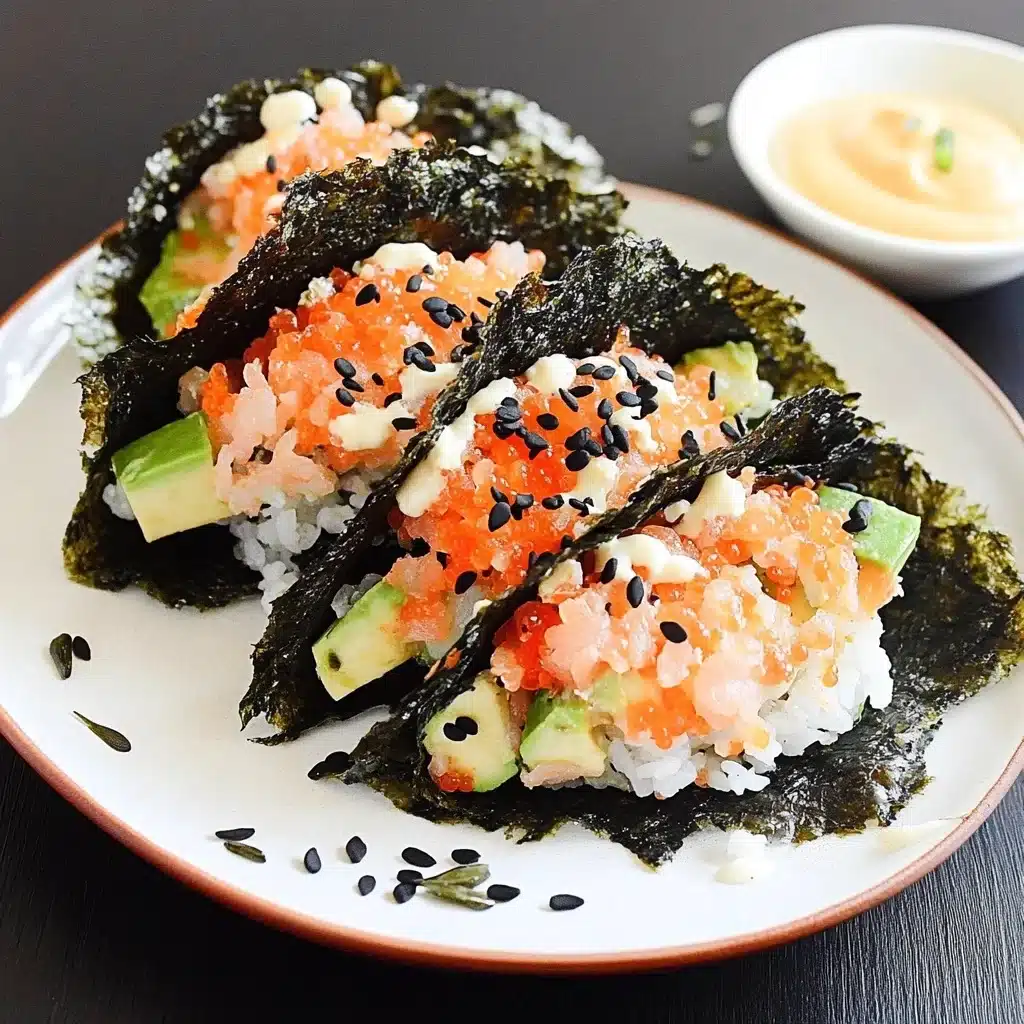Have you ever found yourself torn between craving sushi and tacos? Well, you’re in luck! Sushi tacos are the innovative fusion dish that combines the best of both worlds, melding the fresh, delicate flavors of Japanese cuisine with the handheld convenience of Mexican street food. This culinary creation is taking social media by storm, and for good reason – these eye-catching, flavor-packed bites are as fun to make as they are to eat!
In this comprehensive guide, I’ll walk you through creating perfect sushi tacos at home, from preparing authentic sushi rice to crafting crispy nori taco shells and assembling a variety of mouthwatering fillings. Whether you’re planning a unique dinner party dish or just want to elevate your weeknight cooking routine, these sushi tacos will impress even your most culinary-inclined friends and family.
Let’s dive into this delightful east-meets-west creation that proves fusion cuisine, when done right, can be more than just a passing food trend – it can be a genuinely delicious adventure for your taste buds!
What Makes Sushi Tacos So Special
Sushi tacos represent the perfect marriage between Japanese and Mexican culinary traditions, bringing together contrasting yet complementary elements from both cultures. The concept brilliantly merges the clean, delicate flavors and artistic presentation of sushi with the handheld convenience and bold personality of tacos.
What makes this fusion dish truly sing is the interplay of textures and temperatures: crispy nori shells, warm, vinegared rice, cool fresh vegetables, and tender fish create a multi-dimensional eating experience. The umami richness of soy sauce and the bright pop of pickled ginger find new life when presented in taco form.
Beyond their delicious flavor profile, sushi tacos are incredibly versatile. They can be customized endlessly based on your preferences or dietary needs – opt for plant-based fillings for a vegan version, experiment with different proteins, or adjust the spice level to suit your taste. They also make for a stunning presentation, with the colorful ingredients creating an Instagram-worthy dish that’s perfect for entertaining.
Perhaps most importantly, sushi tacos embody the joyful spirit of fusion cuisine – they’re playful, unexpected, and encourage culinary exploration without taking themselves too seriously. They respect the traditions they borrow from while creating something entirely new and exciting.
Understanding Key Ingredients for Perfect Sushi Tacos
The Rice Foundation
At the heart of any good sushi dish – including sushi tacos – is properly prepared sushi rice. This isn’t just any rice; it’s a short-grain Japanese variety that becomes sticky when cooked, allowing it to hold together when pressed. The characteristic vinegar seasoning (known as sushi-su) gives the rice its distinctive tangy flavor that balances the other ingredients.
When preparing sushi rice, thorough rinsing is crucial to remove excess starch that could make your rice too gummy. The post-cooking seasoning process, where you fold in the vinegar mixture while the rice is still warm, allows the grains to absorb the flavors evenly while cooling. This step transforms plain rice into proper sushi rice with its characteristic glossy appearance and balanced sweet-tangy profile.
For sushi tacos specifically, the rice should be cooled to room temperature before assembly. This prevents the nori shells from becoming soggy while still maintaining enough stickiness to adhere to the shell and hold the other ingredients in place.
Crafting the Perfect Nori Taco Shells
The ingenious element of sushi tacos is the nori “taco shell,” which replaces the traditional corn or flour tortilla. Nori, the dried seaweed sheets traditionally used to wrap maki rolls, brings a distinctive oceanic umami flavor that complements the fish and rice perfectly.
The innovation in this recipe is transforming flat, crisp nori sheets into taco-shaped vessels. This is achieved by coating them in a simple flour batter before frying, which adds structural integrity while maintaining flexibility. The quick frying process creates a shell that’s crisp enough to hold fillings but still pliable enough to fold without shattering.
The technique of draping the freshly fried nori over a cylindrical object (like a wooden spoon handle) while still warm allows it to cool in the classic taco shape. Timing is everything here – too much frying will make the nori brittle, while too little will leave it soggy.
Fresh Fillings: The Heart of Sushi Tacos
When it comes to fillings, sushi tacos embrace the same fresh, high-quality ingredients found in traditional sushi, but with a more playful presentation. Sushi-grade fish is essential if you’re using raw seafood – this designation means the fish has been frozen to kill potential parasites and is safe for raw consumption.
The combination of creamy avocado, crisp cucumber, and sweet shredded carrots provides a perfect textural counterpoint to the fish and rice. The optional spicy mayo sauce (sriracha mixed with mayonnaise) adds a creamy heat that ties everything together, while pickled ginger brings palate-cleansing brightness.
What makes the filling special is the balance – each ingredient should be cut to appropriate sizes to ensure each bite contains a harmonious mix of flavors and textures. Unlike traditional sushi where ingredients are often wrapped tightly together, sushi tacos allow for a more generous, free-form arrangement of fillings, making each bite a slightly different experience.
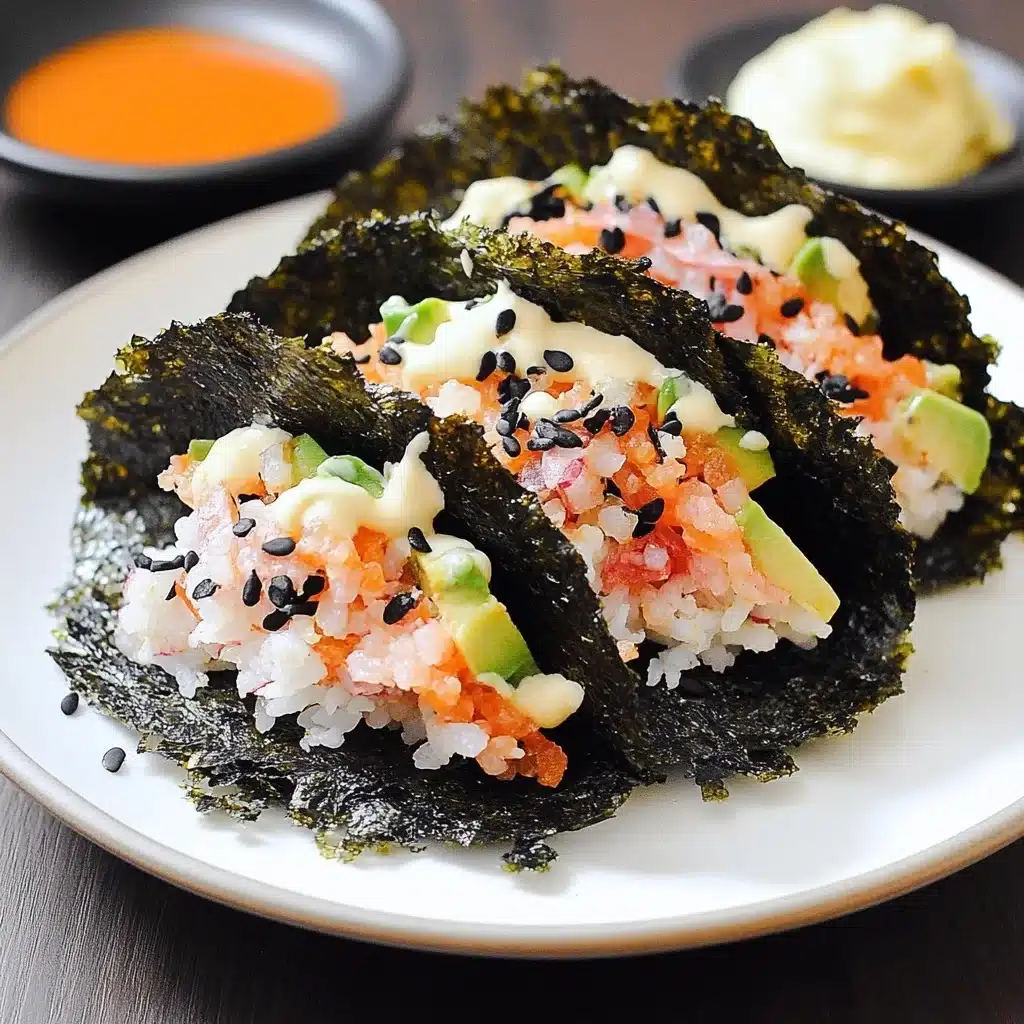
Step-by-Step Guide to Making Sushi Tacos
Preparing Perfect Sushi Rice
The foundation of great sushi tacos starts with perfectly seasoned rice. Begin by measuring 1½ cups of sushi rice into a fine-mesh strainer. Rinse the rice under cold water, gently agitating with your fingers, until the water runs clear – usually about 4-5 rinses. This removes excess starch that would make the rice too sticky.
Transfer the rinsed rice to a medium saucepan and add 2 cups of cold water. Bring to a boil over medium-high heat, then reduce to low, cover, and simmer for 18-20 minutes until all water is absorbed and rice is tender. Remove from heat and let stand, covered, for 10 minutes.
While the rice cooks, prepare your sushi seasoning by combining ¼ cup rice vinegar, 2 tablespoons sugar, and 1 teaspoon salt in a small saucepan. Heat gently just until the sugar and salt dissolve – do not boil. This mixture is called sushi-su.
Transfer the cooked rice to a wide, non-metallic bowl (traditionally, a wooden hangiri is used, but any large glass or ceramic bowl works). Using a flat wooden rice paddle or spatula, gently spread the rice in an even layer. Drizzle the vinegar mixture evenly over the rice and fold it in using a cutting motion, being careful not to mash the grains. Fan the rice as you mix to help it cool and achieve a glossy finish.
Allow the rice to cool to room temperature before assembling your sushi tacos. The rice should be sticky enough to hold together but not gummy, with distinct grains that have a pleasant tangy-sweet flavor.
Creating Crispy Nori Taco Shells
The innovative taco shell is what transforms this dish from standard sushi to exciting fusion cuisine. Start by cutting your nori sheets in half – you’ll want rectangular pieces that will form appropriately sized taco shells. Have these ready before preparing your batter, as the process moves quickly once you begin frying.
In a shallow bowl, whisk together 1 cup all-purpose flour with 1 cup water until smooth. The consistency should be similar to pancake batter – thin enough to create a light coating but thick enough to adhere to the nori.
Heat about ½ inch of vegetable oil in a skillet to approximately 350°F (175°C). You can test the temperature by dropping a small amount of batter into the oil – it should sizzle immediately but not smoke or burn.
Working with one piece of nori at a time, dip it completely in the batter, allowing excess to drip off. Carefully place the battered nori in the hot oil and fry for about 30-45 seconds per side until lightly golden and crisp but still flexible.
Using tongs, carefully remove the fried nori and immediately drape it over a wooden spoon handle or the edge of a spatula positioned over a plate to create the taco shell shape. The nori will harden as it cools, typically within 30-60 seconds, creating a crispy yet pliable shell. Continue this process with the remaining nori pieces, adjusting the oil temperature as needed.
For best results, use the shells within a few hours of making them. If you need to store them briefly, place them in a single layer in an airtight container, but be aware that they may lose some crispness over time.
Preparing and Assembling the Fillings
The beauty of sushi tacos lies in their customizability, but there are some techniques that ensure the best results. First, prepare all your fillings before assembly, as the process goes quickly once you start.
If using raw fish, ensure it’s sushi-grade and keep it refrigerated until just before use. Dice it into small, bite-sized pieces (about ¼-inch cubes) for the best texture experience. In a small bowl, combine the diced fish with 2 tablespoons mayo and 1 teaspoon sriracha (adjust to your heat preference), gently folding to coat the fish without breaking it apart.
For the vegetables, julienne the cucumber into thin matchsticks, shred the carrot using a grater or vegetable peeler, and dice the avocado into small cubes just before assembly to prevent browning. Drain the pickled ginger well to avoid excess moisture in your tacos.
To assemble, hold a crispy nori taco shell and place about 2 tablespoons of sushi rice along the bottom, gently pressing it to adhere to the shell. Layer your protein mixture over the rice, followed by avocado, cucumber, and carrots. Add a few pieces of pickled ginger for brightness.
Finish each taco with a sprinkle of sesame seeds and a light drizzle of soy sauce. For an extra touch of elegance, add small dollops of wasabi or microgreens as a garnish. Serve immediately for the best texture contrast between the crispy shell and fresh fillings.
Sushi Tacos Recipe
Ingredients
For the Sushi Rice:
- 1½ cups sushi rice
- 2 cups water
- ¼ cup rice vinegar
- 2 tablespoons sugar
- 1 teaspoon salt
For the Taco “Shells”:
- 6 small seaweed sheets (nori), halved
- 1 cup all-purpose flour
- 1 cup water
- Oil for frying
Filling Options (mix & match your favorites!):
- 1 cup sushi-grade tuna or salmon, diced
- 1 avocado, diced
- 1 small cucumber, julienned
- 1 medium carrot, shredded
- Pickled ginger, to taste
- 2 tablespoons mayo
- 1 teaspoon sriracha (optional)
- Sesame seeds, for garnish
- Soy sauce, for drizzling
Equipment Needed
- Medium saucepan with lid
- Fine-mesh strainer
- Wooden or rice paddle
- Large mixing bowl
- Small saucepan
- Skillet or frying pan
- Wooden spoon or spatula for shaping shells
- Tongs
- Cutting board and sharp knife
- Paper towels
- Serving platter
Step-by-Step Instructions
- Prepare the Sushi Rice:
- Rinse the rice in cold water until the water runs clear.
- Combine rice and water in a medium saucepan. Bring to a boil, then reduce heat to low.
- Cover and simmer for 18-20 minutes until water is absorbed and rice is tender.
- While rice cooks, mix rice vinegar, sugar, and salt in a small saucepan. Heat gently until sugar dissolves.
- Transfer cooked rice to a large bowl and gently fold in the vinegar mixture.
- Allow to cool to room temperature.
- Create the Taco Shells:
- Cut nori sheets in half to create rectangles.
- Whisk flour and water together to create a thin batter.
- Heat oil in a skillet over medium-high heat.
- Dip each nori piece into the batter, allowing excess to drip off.
- Fry each piece until crispy but still flexible, about 30-45 seconds per side.
- Immediately drape over a wooden spoon handle to form a taco shape and hold until set.
- Prepare the Fillings:
- If using raw fish, mix with mayo and sriracha in a small bowl.
- Prepare vegetables: julienne cucumber, shred carrot, dice avocado.
- Drain pickled ginger.
- Assemble the Sushi Tacos:
- Place about 2 tablespoons of sushi rice in each taco shell.
- Layer with fish mixture, avocado, cucumber, and carrot.
- Add a few pieces of pickled ginger.
- Sprinkle with sesame seeds and drizzle lightly with soy sauce.
- Serve immediately.
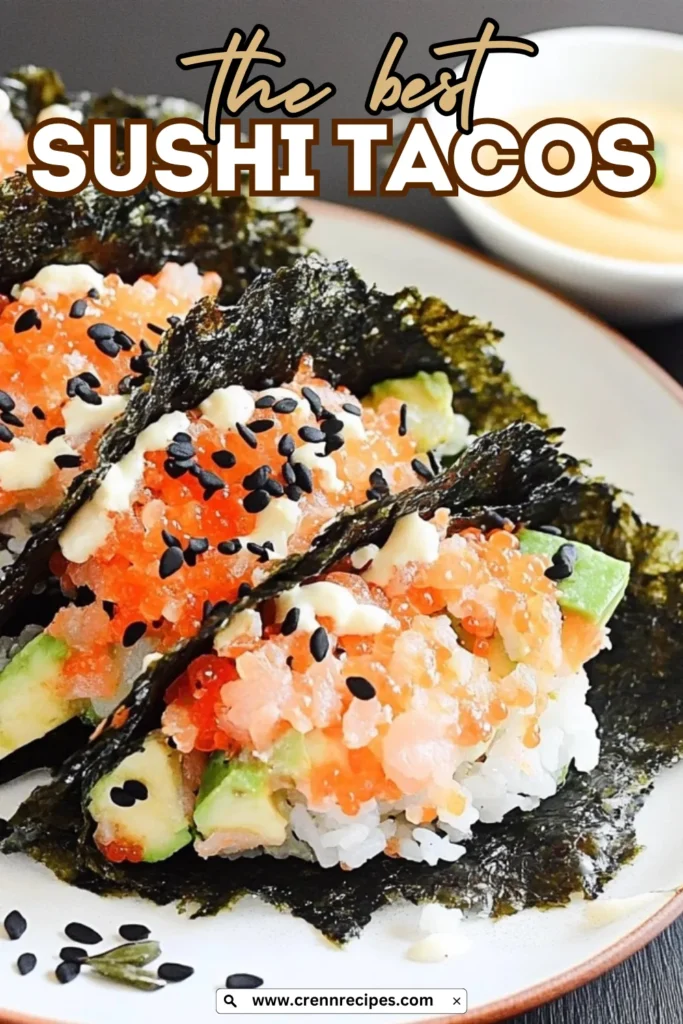
Expert Tips for Perfect Sushi Tacos
Common Mistakes to Avoid
Creating beautiful sushi tacos is an art that combines techniques from multiple culinary traditions. Avoiding these common pitfalls will help you achieve the best results:
One of the most frequent mistakes is overloading the taco shells. Unlike their sturdier Mexican counterparts, nori taco shells are relatively delicate. Overfilling can cause them to tear or collapse when picked up. Instead, apply thin layers of each component and focus on balance rather than quantity.
Another critical error is not properly draining the fillings. Excess moisture from vegetables or sauces can quickly make the crispy shells soggy. Pat fish dry with paper towels before mixing with sauce, thoroughly drain pickled ginger, and consider salting and draining cucumber briefly before assembly.
Timing is everything with sushi tacos. Assembling them too far in advance leads to sad, soggy shells that lose their structural integrity. Plan to make these just before serving, or at most, prepare all components separately and assemble right before your guests arrive.
Finally, many home cooks go overboard with soy sauce, drowning the delicate flavors of the fish and rice. Remember that soy sauce is highly salty and should be used sparingly – just a light drizzle is sufficient to enhance rather than overwhelm.
Creative Variations
The basic sushi taco format offers endless possibilities for creative interpretation. Here are some exciting variations to explore:
For a vegetarian version, replace the fish with tamari-marinated tofu or tempeh, or try thinly sliced and seasoned mushrooms for a meaty umami flavor without the animal protein. Crispy tempura vegetables also make an excellent filling option.
Experiment with different seafood options – try cooked shrimp with a spicy mayo, seared scallops with a citrus ponzu, or even crab salad for a California roll-inspired sushi taco. Just remember that any seafood should be of the highest quality.
The sauce elements can be customized as well. Try a wasabi-avocado cream, eel sauce drizzle, or yuzu-kosho for more adventurous palates. A mango-habanero salsa bridges the gap between Japanese and Mexican traditions beautifully.
For an extra-special presentation, try using black sushi rice or adding a thin layer of tobiko (flying fish roe) for a pop of color and texture. Microgreens, edible flowers, or a flame-torched finish can elevate these tacos to restaurant-quality presentation.
Serving and Presentation Ideas
Sushi tacos are as much about visual appeal as they are about flavor, so presentation matters. Serve them standing upright in a specialized taco holder, or create your own by folding aluminum foil into a corrugated shape that holds the tacos in position.
For a buffet-style gathering, consider a DIY sushi taco bar where guests can assemble their own creations. Prepare the shells and rice in advance, then offer various fillings, sauces, and garnishes in separate bowls. This interactive approach makes for a memorable dining experience and accommodates different dietary preferences.
Garnishing is where you can really make these tacos shine. A sprinkle of black and white sesame seeds adds visual interest and subtle nutty flavor. Thinly sliced scallions, micro cilantro, or a small dollop of tobiko on top brings color and freshness. Even a light dusting of Japanese togarashi spice blend can add a beautiful finish.
Pair your sushi tacos with appropriate accompaniments like edamame, miso soup, or a simple seaweed salad. For beverages, Japanese beer, sake, or a cucumber-infused water complement the flavors beautifully. Consider serving with extra soy sauce, wasabi, and pickled ginger on the side for guests to adjust flavors to their liking.
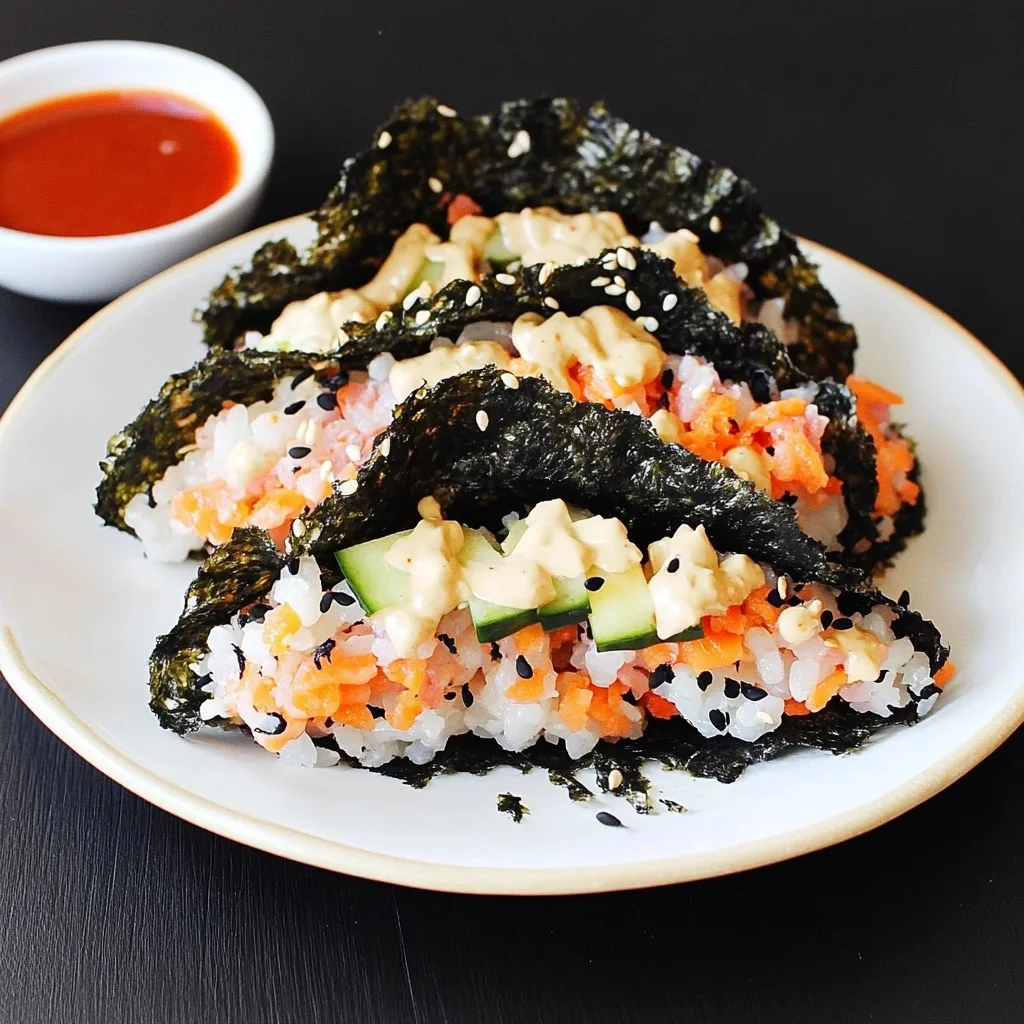
Health Benefits of Sushi Tacos
Beyond their incredible flavor, sushi tacos offer numerous nutritional benefits. When prepared with high-quality ingredients, they represent a well-balanced meal containing protein, healthy fats, complex carbohydrates, and various micronutrients.
The nori shells are packed with minerals, particularly iodine, which supports thyroid function. They also contain vitamins A, C, and E, along with significant amounts of protein and fiber. Seaweed is one of the few plant sources of vitamin B12, making these tacos nutritionally unique.
Fresh fish provides high-quality protein and omega-3 fatty acids, which support heart and brain health. Salmon is particularly rich in these beneficial fatty acids, along with vitamin D and selenium. The vegetables add fiber, vitamins, and antioxidants – avocado contributes heart-healthy monounsaturated fats, while cucumber and carrots provide hydration and beta-carotene.
Even the sushi rice offers benefits when properly prepared. The vinegar used in seasoning may help stabilize blood sugar levels and has antimicrobial properties. When using brown sushi rice (a possible variation), you’ll add even more fiber and nutrients to your meal.
By controlling portions and ingredients, sushi tacos can be part of a balanced, nutrient-dense diet that satisfies cravings for both sushi and tacos without the heaviness sometimes associated with either dish in its traditional form.
Frequently Asked Questions About Sushi Tacos
Can I make components of sushi tacos ahead of time?
Yes, several elements can be prepared in advance. The sushi rice can be made up to 24 hours ahead and stored covered at room temperature (not refrigerated, which hardens the rice). The nori shells should ideally be fried shortly before serving but can be made a few hours ahead if kept in a single layer in an airtight container. Vegetables can be prepped several hours in advance and stored in the refrigerator. However, final assembly should happen just before serving to maintain the crispy texture of the shells.
Is it safe to use raw fish in sushi tacos?
When using raw fish, it’s essential to purchase sushi-grade or sashimi-grade fish from a reputable source. These designations indicate the fish has been frozen to specific temperatures to kill potential parasites. Store raw fish properly in the coldest part of your refrigerator and use it the same day you purchase it. If you’re concerned about using raw fish, cooked seafood options like poached shrimp, crab, or even seared tuna work beautifully in these tacos.
Can I make sushi tacos vegetarian or vegan?
Absolutely! Sushi tacos are highly adaptable to vegetarian and vegan diets. For vegetarian versions, simply omit the fish and focus on vegetables like avocado, cucumber, thinly sliced radish, shredded carrot, and pickled vegetables. For a protein boost, consider adding thin slices of tamari-marinated tofu or tempeh. Vegan versions would additionally require replacing the mayo with a plant-based alternative made from aquafaba or tofu. The umami flavor typically provided by fish can be replicated with ingredients like miso paste or roasted mushrooms.
What’s the best way to eat sushi tacos without making a mess?
Sushi tacos are indeed a bit messy – that’s part of their charm! To minimize the mess, hold the taco slightly tilted over your plate, with the opening angled upward. Take bites from one end rather than from the top, which helps keep the filling inside. Having plenty of napkins on hand is definitely recommended. For a more formal setting, you might consider serving smaller, two-bite sized sushi tacos that can be consumed in one or two bites.
Can I use store-bought taco shells instead of making nori shells?
While you could technically use store-bought hard taco shells as a shortcut, the result would be quite different from traditional sushi tacos. The nori brings a distinctive umami flavor that complements the other Japanese ingredients. If you’re short on time, an alternative would be to use soy wrappers (available at Asian grocery stores) which can be shaped into taco forms without frying, though they won’t have the same crispy texture. For a quick alternative that maintains some of the Japanese flavor profile, you could use large butter lettuce leaves as “taco shells” for a fresh, lighter version.
Why Sushi Tacos Will Become Your New Favorite Fusion Dish
Sushi tacos represent the perfect intersection of two beloved culinary traditions, bringing together the fresh, clean flavors of Japanese cuisine with the casual, handheld fun of Mexican street food. They offer a playful yet sophisticated eating experience that surprises and delights with every bite.
What makes these tacos truly special is their versatility – they can be customized endlessly to suit different dietary preferences and ingredient availability. They’re equally appropriate for a casual family dinner, a festive dinner party centerpiece, or an impressive date night creation. The combination of crispy shell, seasoned rice, fresh seafood, and vibrant vegetables creates a perfect balance of flavors and textures that elevates this fusion dish beyond novelty status to something genuinely crave-worthy.
I encourage you to try this recipe and make it your own! Experiment with different fillings, play with the presentation, and share your creations with friends and family. Sushi tacos are more than just a meal – they’re a conversation starter, a culinary adventure, and a celebration of the creative potential that exists when cultural boundaries in food are joyfully crossed.
More Related Recipes You Might Enjoy
- Summer Lemon Herb Chicken Veggie Bowls – Another fresh, vibrant dish that combines protein and vegetables in a beautiful presentation
- Christmas Eve Cinnamon Vanilla Creamy Custard Pie – If you’re looking for a special dessert to follow your sushi tacos
- Sushi Wrap – A different take on fusion sushi that maintains the flavors you love in a convenient format
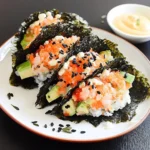
Sushi Tacos: 7 Amazing Secrets for the Ultimate Fusion Dish
- Total Time: 55 minutes
- Yield: 12 sushi tacos (4 servings) 1x
- Diet: Halal
Description
Sushi tacos are a creative fusion dish that combines Japanese and Mexican cuisines. Crispy nori shells are filled with seasoned sushi rice, fresh fish, avocado, and vegetables, then garnished with sesame seeds and drizzled with spicy mayo for a delicious handheld treat that’s perfect for entertaining.
Ingredients
- 1½ cups sushi rice
- 2 cups water
- ¼ cup rice vinegar
- 2 tablespoons sugar
- 1 teaspoon salt
- 6 small seaweed sheets (nori), halved
- 1 cup all-purpose flour
- 1 cup water
- Oil for frying
- 1 cup sushi-grade tuna or salmon, diced
- 1 avocado, diced
- 1 small cucumber, julienned
- 1 medium carrot, shredded
- Pickled ginger, to taste
- 2 tablespoons mayo
- 1 teaspoon sriracha (optional)
- Sesame seeds, for garnish
- Soy sauce, for drizzling
Instructions
- Rinse the rice in cold water until the water runs clear.
- Cook rice with 2 cups water over medium heat until fluffy (about 18-20 minutes).
- Mix rice vinegar, sugar, and salt together, then gently fold into warm rice. Set aside to cool to room temperature.
- Cut nori sheets in half to create taco-sized pieces.
- Whisk flour and water into a thin batter.
- Heat oil in a skillet over medium-high heat. Dip each nori piece in the batter, then fry until crispy but still flexible (about 1 minute per side).
- Drape fried nori over a wooden spoon handle to shape into a taco form while cooling.
- Mix diced fish with sriracha and mayo if desired.
- Spoon sushi rice into each taco shell.
- Add fish mixture, avocado, cucumber, carrot, and pickled ginger.
- Sprinkle with sesame seeds and drizzle with soy sauce.
- Serve immediately.
Notes
- For best results, use short-grain Japanese rice specifically labeled as sushi rice.
- Ensure you’re using sushi-grade fish if serving raw.
- The nori shells are best when made shortly before serving to maintain crispness.
- Vegetarian option: Replace fish with tamari-marinated tofu or additional vegetables.
- These tacos are best enjoyed immediately after assembly as the shells can become soggy over time.
- Prep Time: 30 minutes
- Cook Time: 25 minutes
- Category: Appetizer, Main Course
- Method: Stovetop, Frying Cuisine
- Cuisine: Fusion, Japanese, Mexican
Nutrition
- Serving Size: 3 tacos
- Calories: 385
- Sugar: 6g
- Sodium: 650mg
- Fat: 12g
- Saturated Fat: 2g
- Unsaturated Fat: 9g
- Trans Fat: 0g
- Carbohydrates: 54g
- Fiber: 3g
- Protein: 15g
- Cholesterol: 25mg

